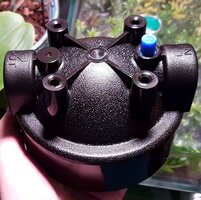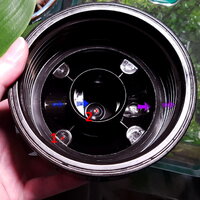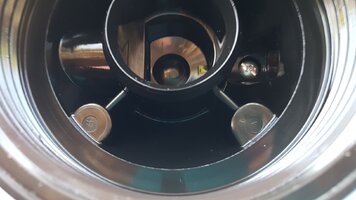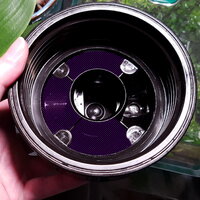Bit late to the party, but on the reactor side on the left if you add another tap then you can easily remove it for cleaning without having to make a mess, the reason I don't clean mine as often as I should

Not too late at all 😁
The filter housing was delayed, so I held off on ordering fittings in case the plans needed changing for a different housing.
So you mean a valve(?) where this arrow points?

On the topic of the reactor in general;
I got the replacement filter housing yesterday, the original housing turned out to be a different product that had been mistakenly placed in the original's box, and that was the only one they had of that model.
They offered me a replacement housing that would work for my needs, and sent me this more expensive one for the same price as the original, which I thought was quite decent 😊
So the filter housing I ended up with is
Spectrum Aqualyze 20" Housing Clear 3/4" Ports. Essentially all the same features except this one doesnt have any brass parts, which is nice for perfectionist reasons
 🚨 Warning: Glorious overthinking below
🚨 Warning: Glorious overthinking below

Now that I have the final housing I can take some measurements 🤓
The inner diameter all the way down on the bottom is ~8 cm.
I think this measurement may differ a bit from brand to brand, all of them will of course be big enough to accept a standard filter cartridge but how much extra room they have on the bottom could be different.
I dont know for certain but based on pictures it looks like it might be the case. The Spectrum brand seems like one of the more tapered ones I have seen online.
Im interested in this measurement since Plan A is a Foxfish style internal setup with a bottle.
I dont know what it is about that setup but
I really like it.
It seems like a very elegant solution to keep the bubbles in motion while also keeping them from getting too far down.
There will probably be some trial and error but I am willing to go to some effort to get it working for me.
I think the noise of small bubbles may be preferable compared to larger bubble noise from for example the Yidao DIY internal venturi.
To see how big of a bottle I can use without compromising flow, im taking the
area of the 8cm circle (~50.2 cm2), and subtracting the area of a 2.5cm circle (~4.9 cm2).
This latter measurement will be akin to my pipework inner diameter, and makes sure that I dont get a flow reduction from things being too narrow around the bottle at the bottom.
(The internal diameter of the pipework wont really exceed 2 cm, but I added a little extra allowance)
So this gives us ~45.3 cm2, meaning I should safely be able to use a bottle with an outer diameter of 7.6cm.
The inner diameter of the housing is probably slightly different a couple of centimeters up, but not even I care about THAT much precision.
So ive made a little measuring template and im gonna start bringing it to the grocery stores so I can inappropriately touch bottles until I find a suitable one.
Now
thats the kind of public weirdness I can really get behind

The average 1.5 liter bottles are too big and the 0.5 liter bottles are a bit small.
I wanna see if I can find something with a suitable neck shape thats between those, to get the most reduction in water velocity for my money.
We're not
playing at CO2 reactor here

I'll also probably need to use the midsection from more than one bottle in order to get it far enough down in the filter housing, but ill figure something out.
Now that I have got a feel for the 20" housing in person I dont think I will need a bypass. This thing is LONG.
With the right bottle (possibly rounder neck bottle if flow is too high), I think I might be able to get it balanced without a bypass.
Ive actually taken the Jebao pump into use already with some temporary(inefficient) plumbing, and based on how its running now I dont think there will be a problem where I need more flow/circulation intensity in the tank itself.
The pump is currently running at the 16% setting (or 40 watts, the display is a bit confusing) and the flow in the tank is
much better than before.
So it seems I wont need to run the pump very hard in order to get the flow in the tank where I want it.
Not having a bypass will uncomplicate things significantly. Although im still thinking about some valves and quick disconnect fittings so maintenance will be relatively easy.
Im not planning to clean it more than once or twice a year hopefully, but making maintenance easy where possible is always good I think.
Ive taken a look at the head of the housing to see what my options are for CO2 entry. I may have gotten lucky because on this model there are four ~5mm tunnels that are used for attaching the housing to a bracket, and these go almost all the way down through the head. Inside the head, the plastic below the tunnels is nice and flat, although the size of any washer would be limited by the outer ring. So thats option 1. Option 2 would be going directly down the middle, but this would put the CO2 pipe right in the middle of the flow. This might be less preferable, because of quantum flux turbulence in the plasma current and whatnot.


The head has three voids that arent really useful and could trap water/air, they are closed off horizontally from the exit by reinforcing walls.


Im considering trying to close these off in some way in order to clean up the design a bit (mostly because I feel like it)
I need to look into if theres a glue that will bond the head material (Polypropylene) to whatever material I could close them off with.
My SO can currently only 3D print with PLA, I think the printer needs a closed warm box to print in ABS or something like that.
PLA is considered ok for aquarium use but it is starch based and breaks down over time, so dont think that will be a good fit for something permanent.
What he can print however, are some custom external hose bends that I can put on the outside of the hoses leading to the filter housing 😃
That way I wont have to waffle about with finding the most gently bending hose elbows and can just get normal hose attachments

Something
like this but just scaled up perhaps

But anyway thats it for a
shortcough-hark post about my reactor project ..for now











